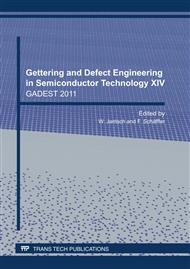p.3
p.17
p.25
p.31
p.35
p.43
p.50
p.56
Room Temperature Direct Band-Gap Emission from an Unstrained Ge P-I-N LED on Si
Abstract:
We present a novel Ge on Si based LED with unstrained i-Ge active region. The device operates at room temperature and emits photons with energy of 0.8 eV. It basically resembles a p-i-n structure formed on a sub-micrometer thin Ge layer. The Ge layer has been grown on Si substrate by utilizing thin virtual buffer, so it becomes stress free but with high threading dislocation density. We show that such forward biased diode generates strong emission, caused by direct band to band transition in Ge. Using an InSb based detector we were able to analyze the emission spectrum in a broad energy range. We show that at low and moderate currents, features belonging to the direct and the indirect band to band electronic transitions are present which are characteristic for Ge. Clearly dominating is the direct transition related peak. Due to the missing stress-related red shift this peak appears close to the desired communication wave length of 1.55 μm. The dependence of radiation intensity on the excitation current follows a power low with exponent of 1.7, indicating that the recombination rate of the competitive nonradiative processes is relatively low. At high excitation currents features appear in the low energetic part of the spectrum. All results presented here are discussed in view of the outcome from measurements on Ge high quality bulk material. The role of the dislocation in the Ge films is discussed.
Info:
Periodical:
Pages:
25-30
Citation:
Online since:
August 2011
Keywords:
Price:
Сopyright:
© 2011 Trans Tech Publications Ltd. All Rights Reserved
Share:
Citation:


